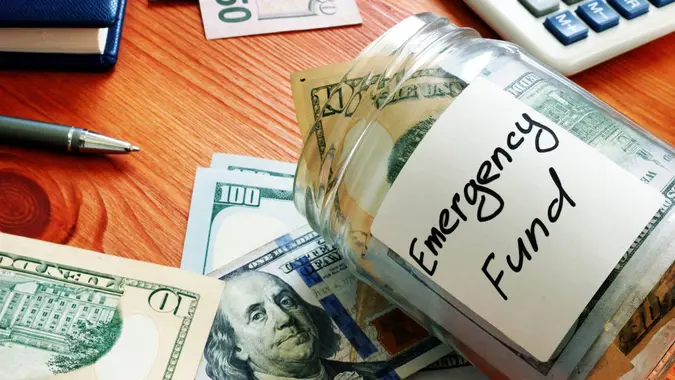10 Frugal Habits To Start Now for a Full Emergency Fund in 2025

Commitment to Our Readers
GOBankingRates' editorial team is committed to bringing you unbiased reviews and information. We use data-driven methodologies to evaluate financial products and services - our reviews and ratings are not influenced by advertisers. You can read more about our editorial guidelines and our products and services review methodology.

20 Years
Helping You Live Richer

Reviewed
by Experts

Trusted by
Millions of Readers
With the ever-increasing possibility of natural disasters, job losses and medical emergencies, maintaining a healthy emergency fund is an essential part of financial planning. And, as it turns out, anyone can accrue one by simply changing their spending habits.
First things first, how much should an emergency fund contain? This will vary depending on lifestyle and number of people per household. But, according to RamseySolutions, an emergency fund should consist of three to six months living expenses — which could mean a range from $12,900 for a single person for three months to $55,200 for a family of four for six months. Let’s take the average of the two: $34,050.
Here are 10 frugal habits to help get you there in 2025.
Cook at Home Instead of Eating Out
Cooking at home a few days a week could save you $2,000 annually, according to Casey Brueske, community education development specialist at PenAir Credit Union.
Ben Watson, vCFO at DollarSprout, added that batch cooking could further save an additional $1,000.
“You can amplify the savings by ‘batch cooking,’ where one meal can cover multiple days, such as a full dinner plus an easy thing to pack in the work or school lunch for the next day,” he said.
Learn To Cut Your Own Hair
This one may take some dedication to the craft, but it could be worth it.
For a haircut, “women every couple months, average $15 to $75 each time, plus tip and shampoo,” stated Watson. On average, that’s $45 plus $10 in tip and shampoo, totaling $55 every visit. Multiply that by 6 times per year and the average woman spends $330 annually on haircuts.
This could stretch for $500 for bi-annual bang trims. Learning to cut hair for a family of four could add up to a potential savings of $2,000.
Reconsider Purchasing Brand Names
Tanya Peterson, vice president at digital personal finance company Achieve, explained that buying store-brand products over name-brand products can save the average consumer 20% to 25% on grocery bills.
“That means a family that spends $500 a month on name-brand groceries could save $100 every month,” stated Peterson. And that amounts to $1,200 per year.
Check Entertainment Offerings at the Local Library
Trading in pricey outings and streaming services for free library offerings could save up to $600 per month, said Peterson. That adds up to a whopping $7,200 per year.
Libraries offer a free selection of e-books, documentary films and TV shows, in addition to workshops like gardening, poetry and balloon painting.
Compare that to $40 to $100 per person to visit an amusement park, $30 per person to visit a movie theatre in Boston (including transportation and popcorn), and $61 per month for video streaming services, and the library becomes a star player in helping build an emergency fund.
Shop With a List
“According to a CapitalOne study, the average consumer spends $282 per month on impulse buys for a projected average of $3,380 per year,” Brueske revealed. “Impulse purchases at a grocery store can increase your bill by 20 to 30%.”
So, before you go grocery shopping, make a list and stick to it!
Re-Think Unlimited Data Plans
Consumer and money saving expert Andrea Woroch stated that a recent study found “72% of unlimited data plan members use no more than 15 GB of data each month so you could save by switching to a lower-tiered plan or move to an online-only wireless carrier.”
She recommended Mint Mobile which offers rates of $20 per month as opposed to Metro by T-Mobile which charges roughly $65 per month. That’s an annual savings of $540 as a result of giving up… absolutely nothing.
Carpool
Sharing driving duties with others saves each person money on fuel costs and car maintenance, explained Melanie Musson, finance expert at Clearsurance.com. That cuts down on each person’s ability to just stop off random places and go shopping.
With Musson’s projected savings of $20 to $50 per month on fuel alone, carpooling could add at least $240 to $600 annually to your emergency fund.
Reconsider Storage Units
Have lots of furniture sitting in a storage unit that’s not even being used? Seems silly to pay $100 per month (or $1,200 per year) on a storage unit to house items with no foreseeable function.
If possible, Peterson encouraged selling unused furniture and considering giving up the storage unit. You may even accrue an additional $2,000 in sales.
Work From Home
According to a Flexjobs.com study, the average person can save $6,000 annually working in a hybrid role and $12,000 fully remote.
Cutting out the cost of fuel, car maintenance, higher car insurance rates, takeout food, work clothes and shoes, pet sitters, and more has a massive impact on one’s wallet.
While this is not a viable option for every profession, it’s encouraged to take advantage of remote options where possible if you’re looking to cut expenses and further contribute to an emergency fund.
Get a Roommate
Living with a stranger off Craigslist typically elicits a loud groan. But, if contributing to an emergency fund is top of mind, there may be no better option.
According to SmartAsset.com, a roommate can save you anywhere from $250 to $1865 per month on a two-bedroom apartment. That’s anywhere from $3,000 to $22,380 annually. Chore chart, anyone?
 Written by
Written by  Edited by
Edited by 

























